Electric eels are simultaneously one of the most notorious and mysterious fish in the world. Since their discovery nearly 250 years ago, they have been reclassified several times, and new discoveries are being made all the time. Belonging to the genus Electrophorus, electric eels only live in certain regions in northeastern South America. While most people know they are capable of producing electricity, there’s much more to electric eels than meets the eye. Here is a list of 10 incredible electric eels facts that you’re sure to find shocking.
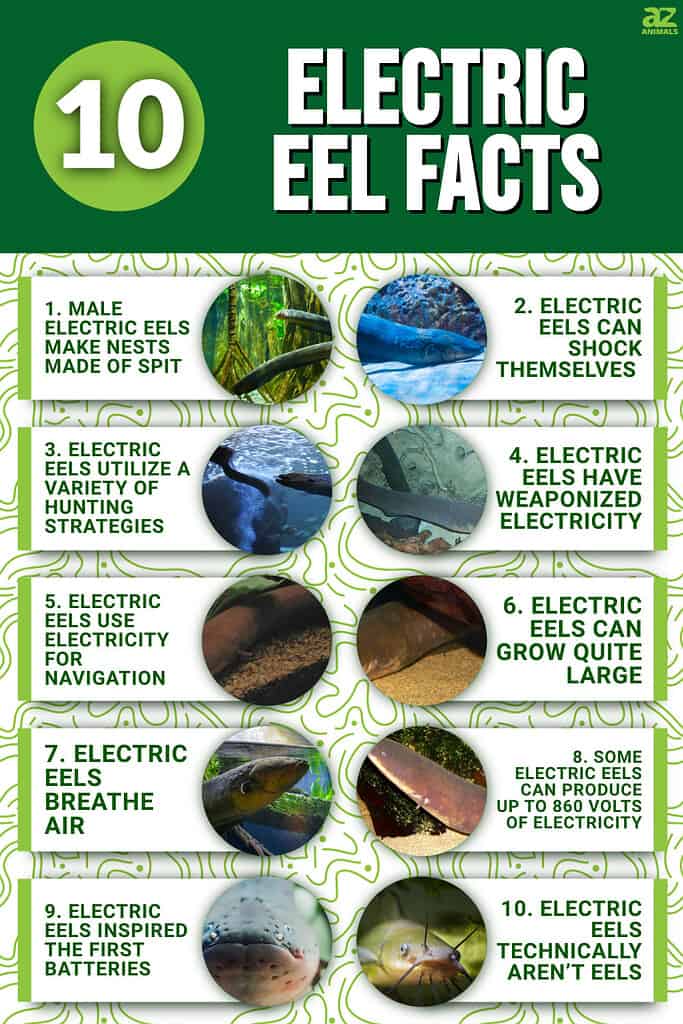
10. Electric Eels Technically Aren’t Eels
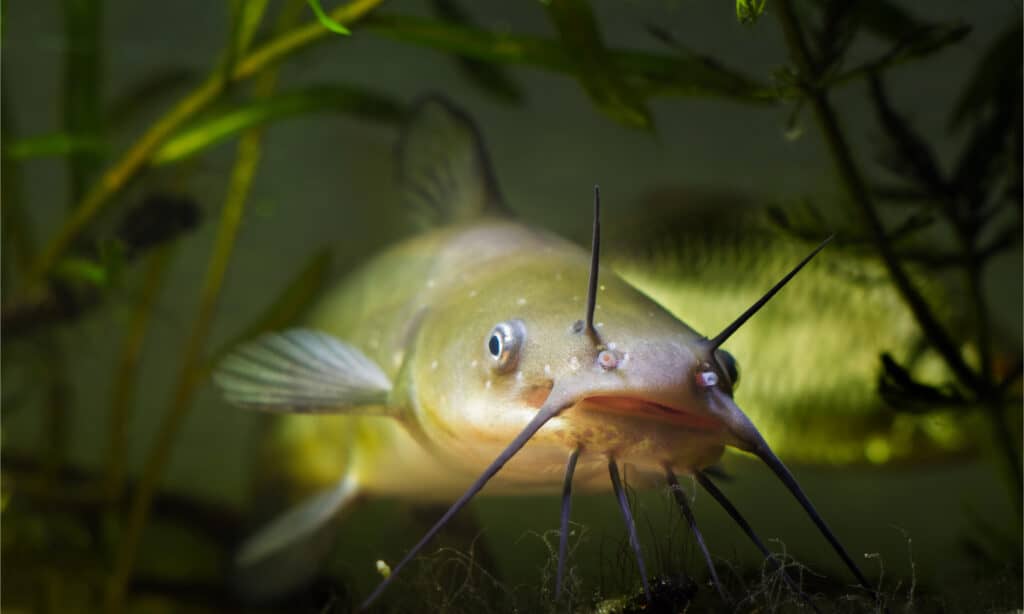
Electric Eels are not considered true eels, they are more closely related to catfish.
©Aleron Val/Shutterstock.com
The first entry on our list of electric eels facts is also one of the most surprising. Despite their name, electric eels aren’t actually true eels. True eels are ray-finned fish that belong to the order Anguilliformes. On the other hand, electric eels belong to the order Gymnotiformes, also known as Neotropical knifefish. In truth, electric eels and other knifefish are more closely related to catfish than to true eels.
Both electric eels and true eels possess distinctive elongated bodies. However, while most true eels live in saltwater, electric eels and other knifefish tend to live in freshwater. Additionally, unlike true eels, electric eels do not possess dorsal fins. Finally, while knifefish and electric eels specifically can produce electricity within their bodies, true eels lack this ability.
9. Electric Eels Inspired the First Batteries
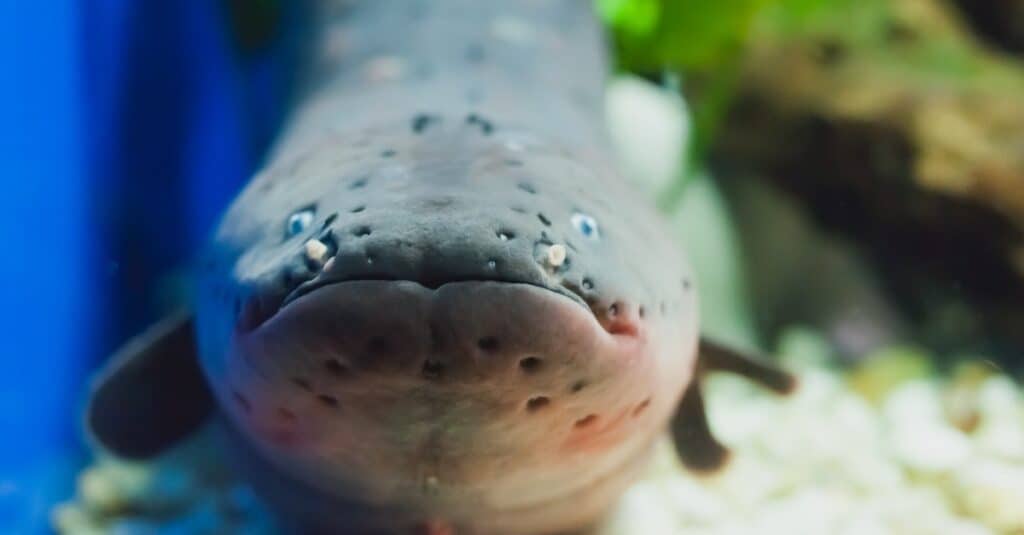
Electric eels inspired the battery.
©iStock.com/stacey_newman
Carl Linnaeus first described electric eels in 1766. Several years later, in 1775, Hugh Williamson released a paper entitled “Experiments and observations on the Gymnotus Electricus, or electric eel.” This paper examined the electroreceptive properties of electric eels in detail. The surgeon John Hunter also conducted his own study of electric eels as well as electric rays.
Together, the findings of Williamson, Hunter, and other researchers appear to have influenced the founders of electrophysiology and electrochemistry – Luigi Galvani and Alessandro Volta. Volta went on to create the voltaic pile in 1799, which historians today widely consider the world’s first electric battery. In honor of this legacy, the electric eel species, Electrophorus voltai, described in 2019, gets its name from Volta.
8. Some Electric Eels Can Produce Up to 860 Volts of Electricity
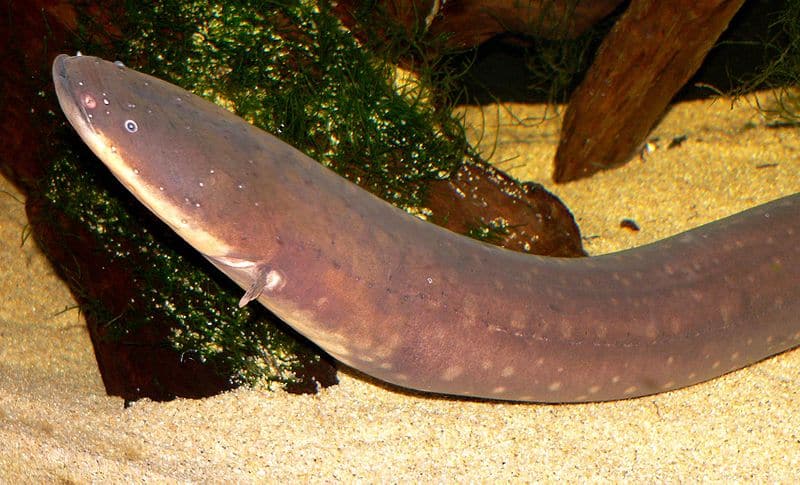
Large electric eels can produce up to 860 volts.
©Stan Shebs, CC BY-SA 3.0, via Wikimedia Commons – License
For nearly 250 years, scientists believed there to be only one electric eel species, Electrophorus electricus. The genus was classified as monotypic all the way up until 2019 when new information came to light that gave researchers reason to pause. At that time, C. David de Santana and others proposed that there are actually 3 different electric eel species based on their varying genetic makeup, habitat, anatomy, and electrical ability.
Electrophorus electricus typically produces around 480 volts. That said, some evidence suggests they may be able to emit up to 500 volts. Meanwhile, Electrophorus varii produces up to 572 volts. However, E. electricus and E. varii pale in comparison to E. voltai. It can emit a maximum of 860 volts, which makes it the strongest known bioelectricity generator in nature. How’s that for some shocking electric eel facts?
7. Electric Eels Breathe Air
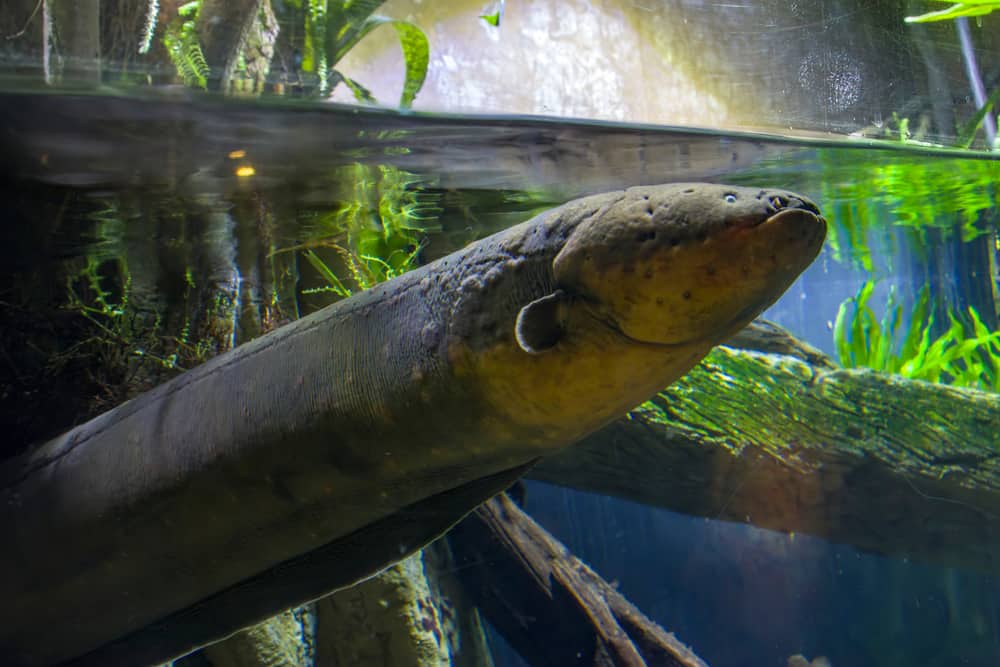
Electric eels live in water and have gills, but they actually breathe air.
©Danny Ye/Shutterstock.com
It’s well-known that electric eels live in water. Specifically, they live in the freshwater habitats of the Amazon and Orinoco River basins of South America. You can find them in various environments including swamps, rivers, creeks, floodplains, and coastal plains. They prefer muddy or brackish water that is relatively calm as opposed to fast-flowing and clear rivers.
Although they live in water and possess gills, electric eels breathe air. Their gills allow them to simply gather some oxygen from the water at lower depths. However, they must still rise to the surface around once every 10 minutes to get enough fresh oxygen. This ability to breathe through the mouth enables them to survive in the otherwise low-oxygen, muddy water.
6. Electric Eels Can Grow Quite Large
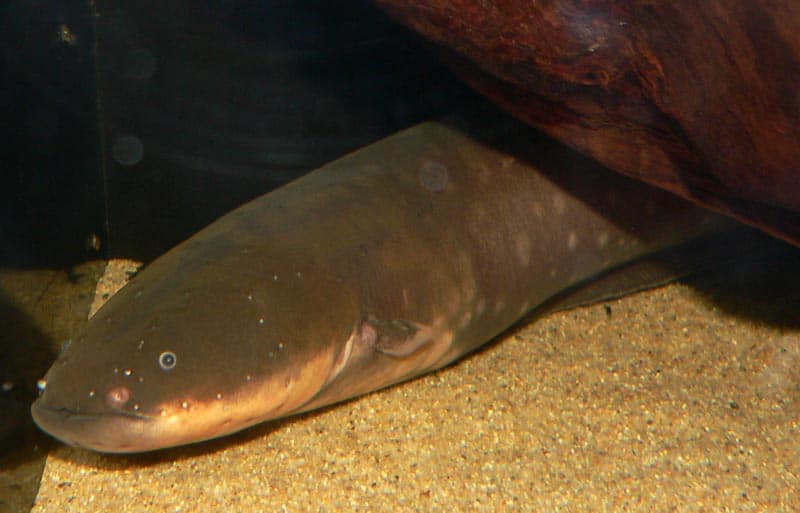
Electric eels can grow up to 8 feet long.
©Stan Shebs, CC BY-SA 3.0, via Wikimedia Commons – License
True eels range in size from only 2 inches to nearly 13 feet long. They vary wildly in appearance, which can make them readily easy to identify.
On the other hand, electric eels all look relatively similar. E. electricus specimens grow to a size of about 6 feet, 7 inches long, and around 44 pounds in weight. As for E. varri, they tend to be relatively indistinguishable from E. electricus, except for the fact they lack the clear band that runs along the body of E. electricus. Meanwhile, E. voltai tend to have flatter, wider heads. Moreover, the largest E. voltai specimens can grow up to 8 feet long. This means they are not only the largest electric eels but also the largest species in the order Gymnotiformes.
5. Electric Eels Use Electricity for Navigation
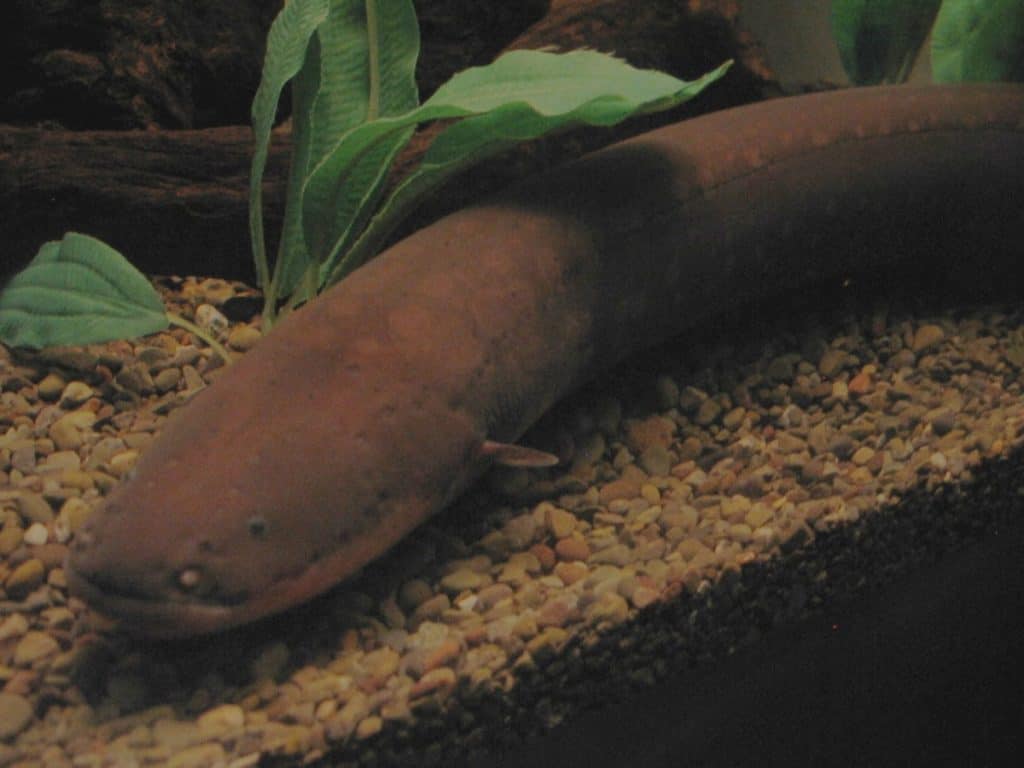
Electric Eels travel with the help of electrolocation, detecting their environment with a low-voltage pulse.
Echolocation is a well-known biological adaptation that allows certain animals to navigate using sound waves. Numerous animals employ echolocation to find their way including bats, whales, and dolphins. Similarly, various animals read magnetic fields to orient themselves, such as birds, butterflies, and sharks.
Electric eels have poor eyesight which is only made worse by their muddy environment. To get around, they developed their own method of navigation thanks to their ability to generate electricity. By emitting a low-voltage pulse, they can utilize electrolocation to detect objects in their immediate area. Even if they can’t see prey hiding in the water, electric eels can still find food by creating an electric outline of the space around them.
4. Electric Eels Have Weaponized Electricity
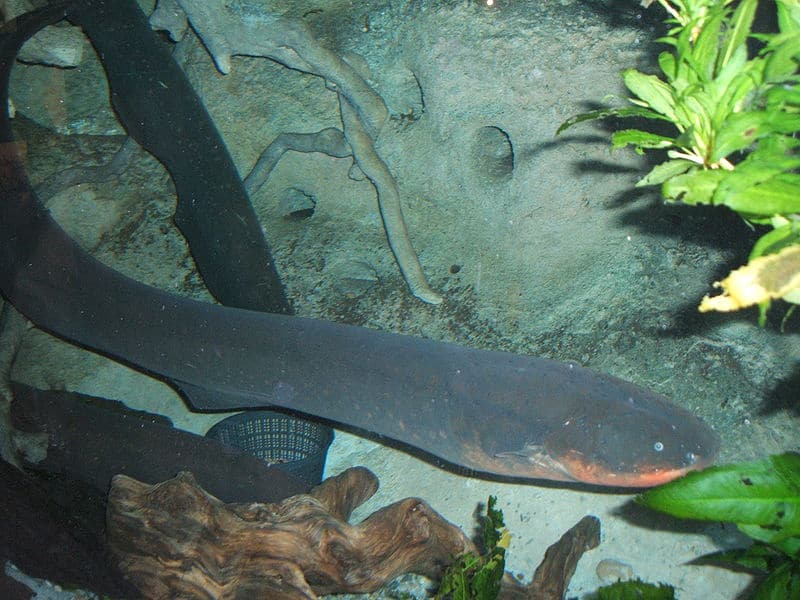
An electric eel (Electrophorus electricus), at the New England Aquarium
Electric eels are capable of producing electricity inside three different organs in the body: the main organ, Hunter’s organ, and Sach’s organ. They can control the amount of electricity they emit from these organs, allowing them to adapt their electricity to different situations. One of the most famous uses of their electricity is as a weapon for catching prey.
Once an electric eel detects prey, it sends a signal to its brain to generate an electric charge similar to a battery. Upon reaching a sufficient voltage it sends out a high-powered volt that is used to stun its prey. Their charge is sometimes enough to kill smaller animals or stun larger ones. Even large animals such as humans and horses can be severely hurt by an electric eel’s charge. While deaths are rare, they occasionally happen, particularly when people go into respiratory failure and then drown in shallow water.
3. Electric Eels Utilize a Variety of Hunting Strategies

Electric eels can use their electricity to stun their prey and ward off predators.
©Cattleya2017/Shutterstock.com
Rather than being simple-minded killers, electric eels employ a variety of different hunting tactics. For years, most scientists believed that electric eels were solitary hunters. While this tends to be true, new evidence suggests that some electric eels use pack tactics. E. voltai have been observed working in groups to herd tetras together and then attack the closely-packed fish.
Electric eels will also modify their shocks depending on the type of prey they’re hunting. If the prey is larger, they may coil themselves around their prey to create more points of contact and deliver a larger jolt. In addition, electric eels don’t just use electricity for offense but also for defense. They will sometimes even fling themselves bodily out of the water to ward off predators and larger animals such as horses.
2. Electric Eels Can Shock Themselves
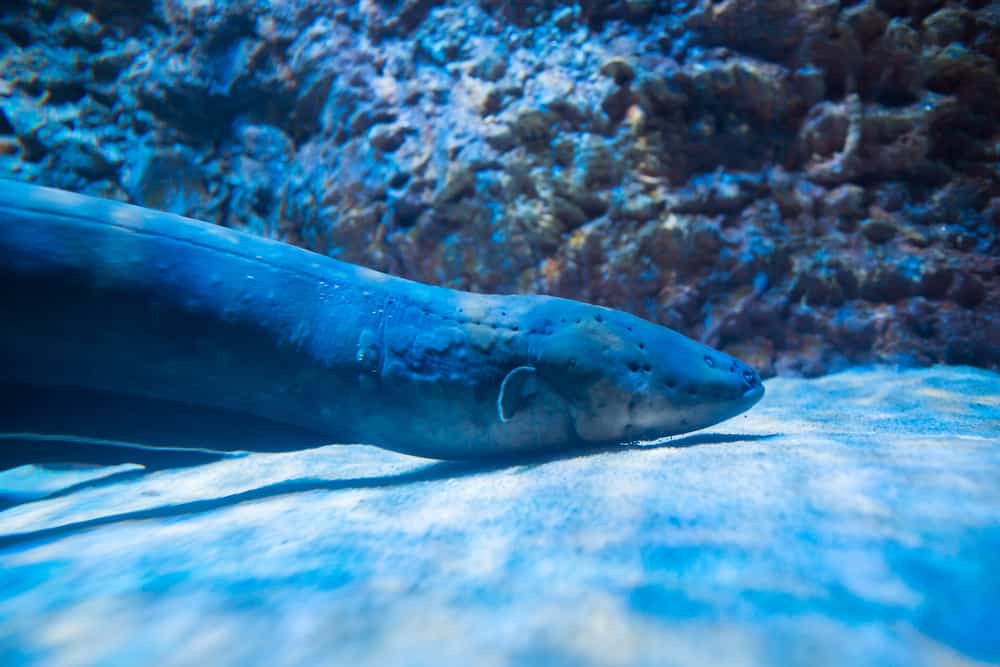
Electric eels can sometimes shock themselves.
©Cuson/Shutterstock.com
Oddly enough, electric eels don’t just pose a threat to other animals. In fact, electric eels have been known to shock themselves from time to time. Normally, electric eels aren’t capable of shocking themselves thanks to their natural insulation. Their thick, greyish-brown skin prevents any electricity from affecting their internal organs, so they don’t have to worry about shocking themselves or other electric eels. However, if an electric eel suffers a wound or injury, electricity can enter through the opening, thereby allowing an eel to shock itself.
1. Male Electric Eels Make Nests Made of Spit

Male
E. electricuseels build nests made of saliva.
©tristan tan/Shutterstock.com
Our last entry happens to also be one of the more unusual electric eel facts. A number of different animals are known for making unusual nests. From intricate hammocks woven from grass to giant underground burrows, you can find all sorts of wild and unusual nests in the animal kingdom. Electric eels go a different route and utilize their own saliva to hold their eggs.
During the dry season, male E. electricus eels collect their spit and use it to create a nest. Their foamy nests can hold up to 3,000 eggs, which the males will guard against predators until the rainy season. Despite their vigilance, only a fraction of the eggs manage to hatch, and even fewer will grow to reach maturity.
The photo featured at the top of this post is © iStock.com/wrangel
Thank you for reading! Have some feedback for us? Contact the AZ Animals editorial team.





